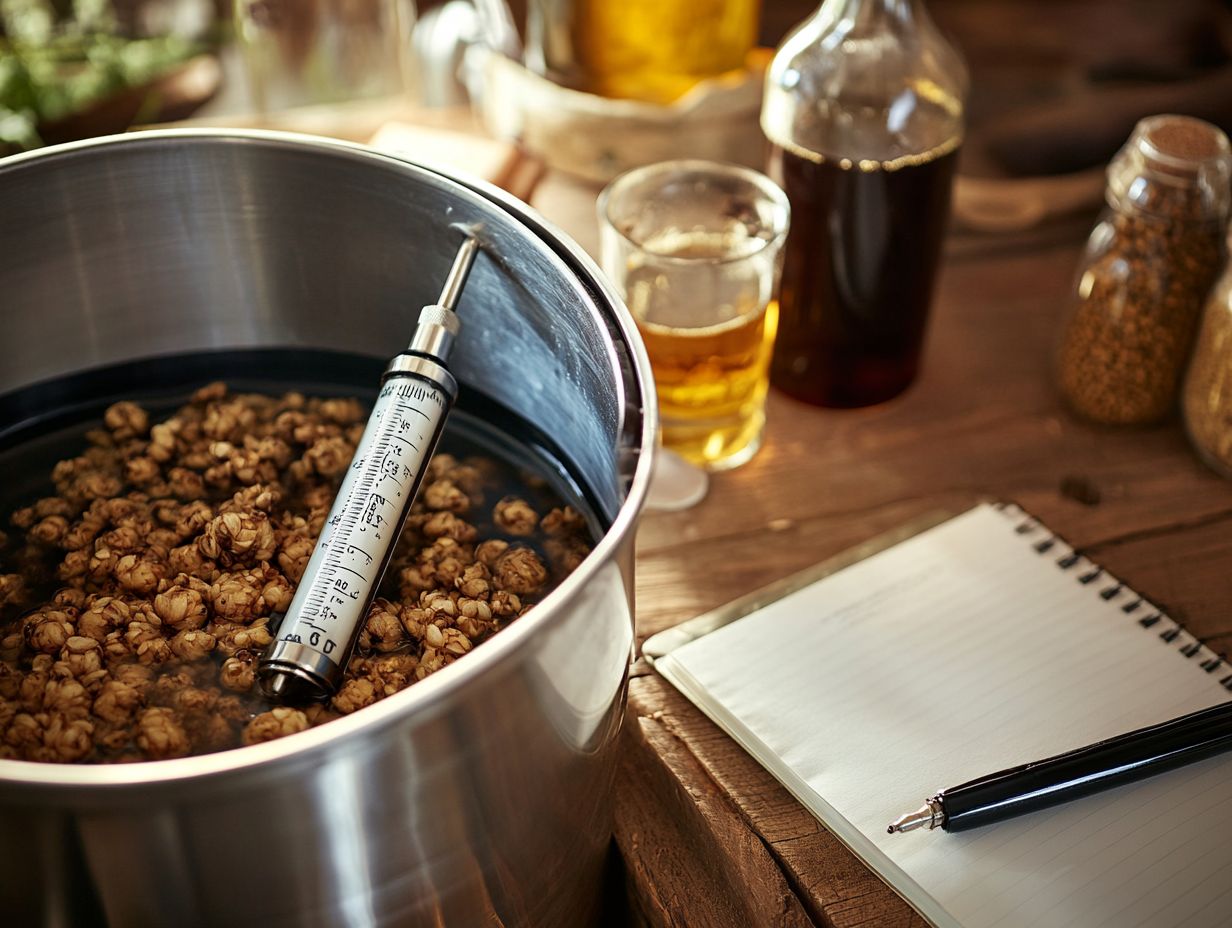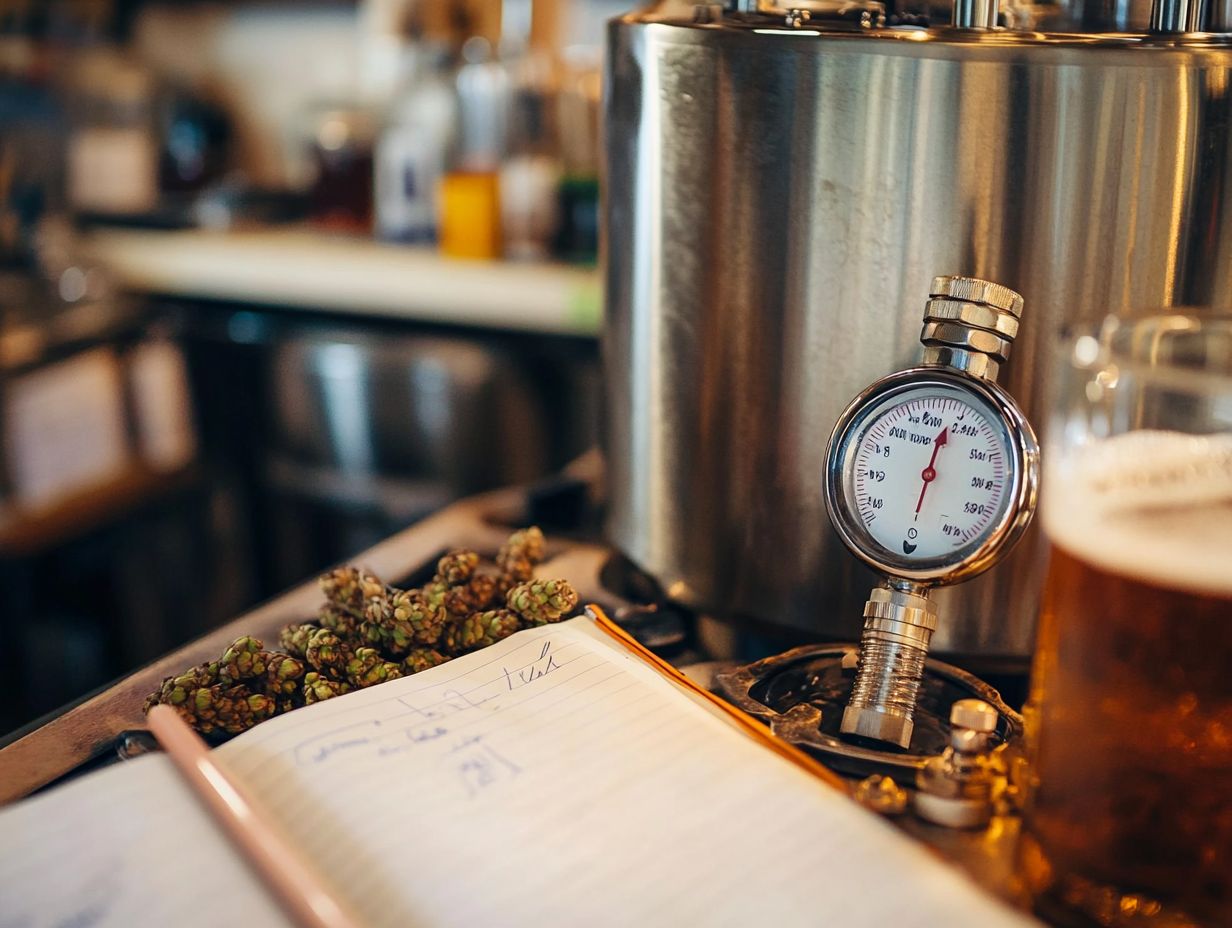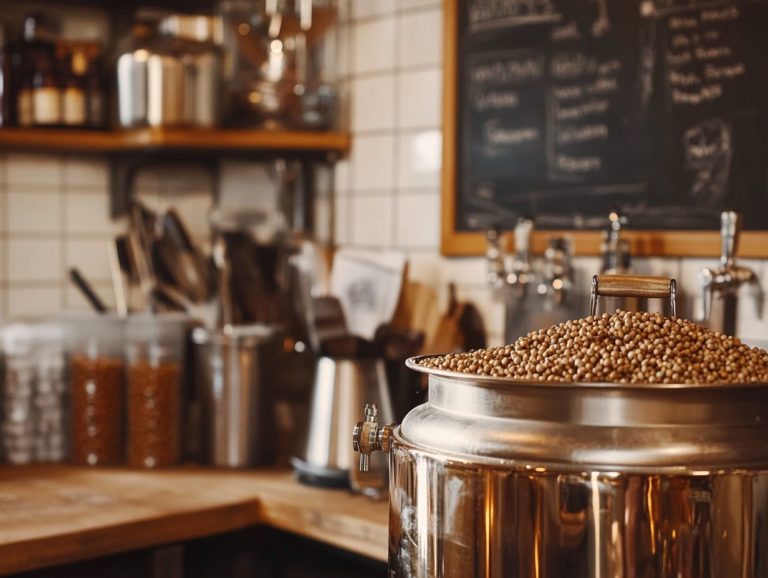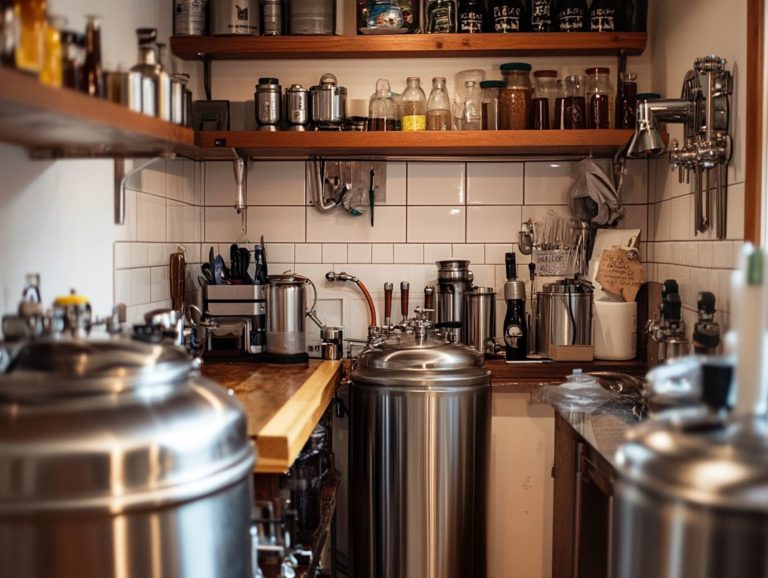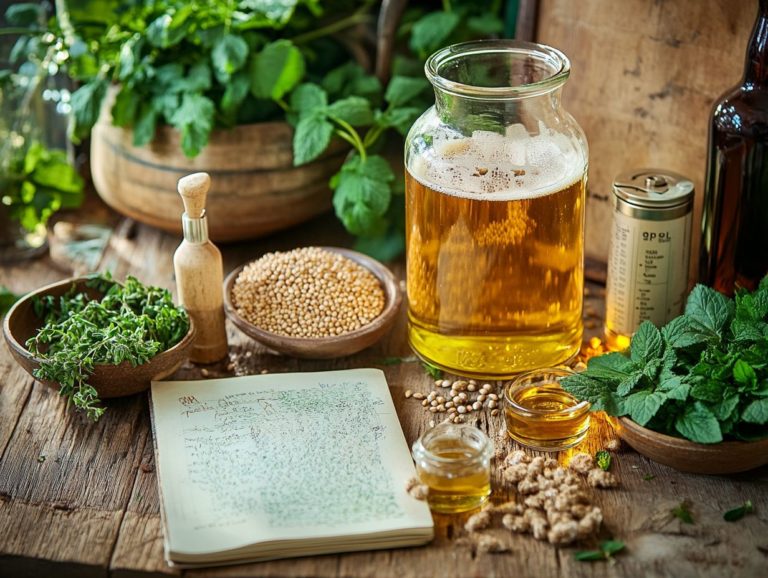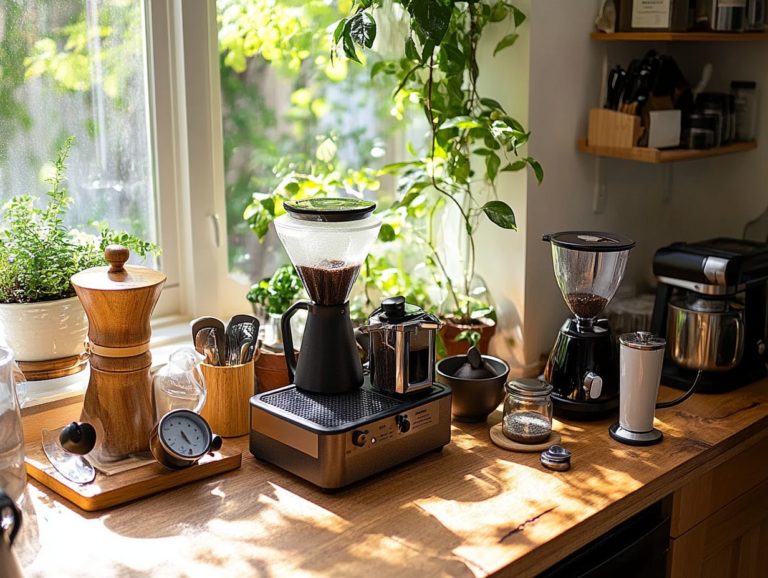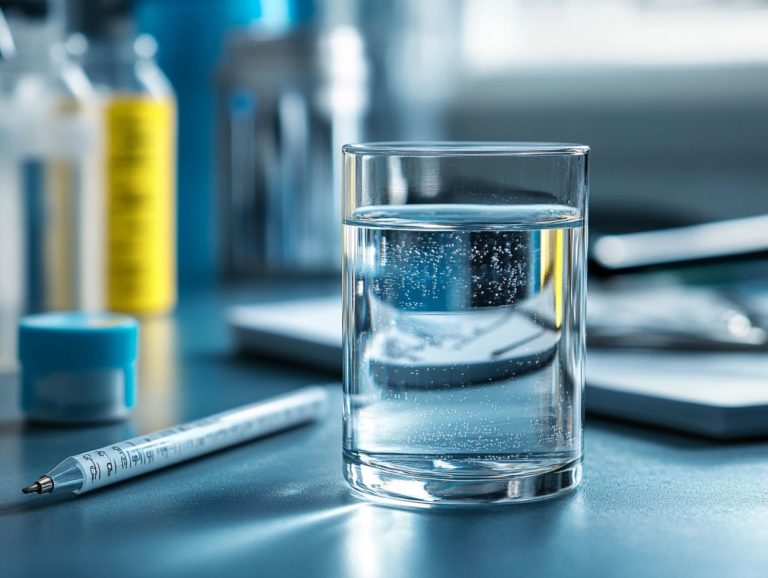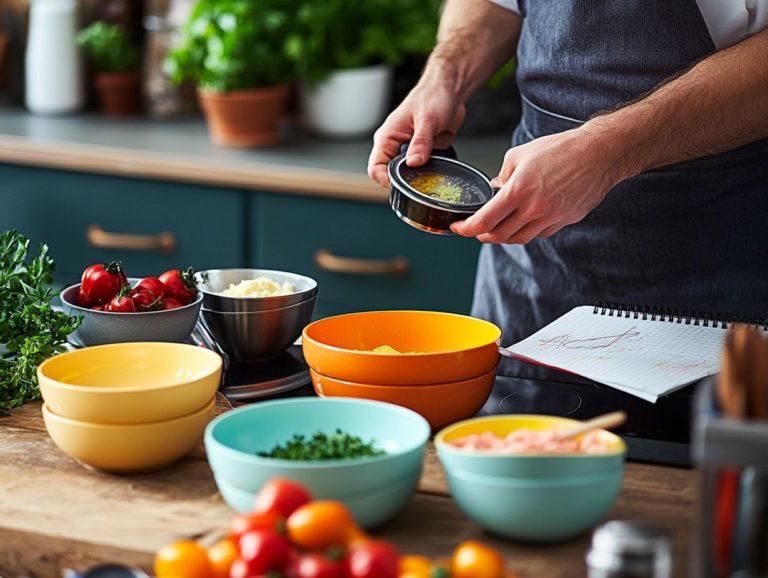5 Essential Temperature Tips for Home Brewing
Brewing beer at home can be an exhilarating and fulfilling hobby, but mastering the art of temperature control is essential for unlocking the best flavors in your brews.
Here are five key brewing tips to help you grasp the significance of temperature in brewing, from investing in a reliable thermometer to understanding the optimal temperature ranges for various beer styles.
You ll also explore common pitfalls that home brewers face and discover strategies to maintain consistency throughout the homebrewing process.
Whether you re just starting out or have some experience under your belt, these insights will elevate your brewing game, empowering you to craft unique and delicious beers that impress.
For additional brewing resources, you can refer to influential books such as “The Joy of Homebrewing” by Charlie Papazian, “Radical Brewing” by Randy Mosher, and “How to Brew” by John Palmer.
Contents
- Key Takeaways:
- 1. Understand the Importance of Temperature in Brewing
- 2. Invest in a Good Thermometer
- 3. Know the Optimal Temperature Range for Different Types of Beer
- 4. Monitor Temperature Throughout the Brewing Process
- 5. Make Adjustments as Needed
- How Does Temperature Affect the Flavor of Beer?
- What Are the Ideal Temperatures for Different Types of Beer?
- What Are the Common Mistakes Home Brewers Make with Temperature?
- How Can One Control Temperature during the Fermentation Process?
- What Are Some Tips for Maintaining Consistent Temperature in Home Brewing?
- How Can One Use Temperature to Create Unique Flavors in Beer?
- Frequently Asked Questions
- Essential Temperature Tips for Home Brewing
Key Takeaways:
1. Understand the Importance of Temperature in Brewing
Understanding the significance of temperature in brewing is essential for you as a homebrewer, as it directly affects the efficiency of processes like the BIAB method and fermentation, ultimately influencing the flavor and quality of your beer. Familiarity with important concepts such as mash temperature, the use of a strike temperature calculator, and managing temperature swings can greatly enhance your brewing experience. Additionally, joining a homebrewing club like the Green Bay Rackers can provide you with community and support to further improve your skills.
With precise control over brewing temperatures, you can achieve the results you desire. Influential authors like Charlie Papazian, Randy Mosher, and John Palmer emphasize these principles in their writings, underscoring their importance in effective homebrewing.
Temperature plays a crucial role during both the mashing and fermentation stages, where precise adjustments can lead to dramatically different outcomes. For example, mashing at temperatures between 150-155 F typically yields a beer with a fuller body, while lower temperatures around 140 F can enhance fermentability.
During fermentation, maintaining a stable temperature is vital; any fluctuations might lead to off-flavors due to yeast stress. John Palmer points out that even minor variations in yeast temperature can have a substantial impact on the final flavor profile.
To illustrate, consider a successful homebrewer who achieved a cleaner lager by employing a temperature-controlled fermentation chamber, showcasing the critical nature of consistent temperature management throughout the brewing process.
2. Invest in a Good Thermometer
Investing in a high-quality thermometer is essential for any homebrewer striving for precise temperature control during the brewing process. After all, inaccurate readings can lead to inconsistent results and, ultimately, subpar beer quality.
To achieve the level of accuracy you desire, you have a range of thermometers at your disposal, including digital and infrared models, each with its own set of unique advantages. Digital thermometers are celebrated for their rapid and reliable readings, making them ideal for monitoring temperatures during critical phases like mashing and boiling. Conversely, infrared thermometers offer the convenience of non-contact measurements, allowing you to check the temperature of larger brewing vessels without interrupting your work.
Incorporating a strike temperature calculator can further streamline your brewing process, helping you ensure that the water temperature is just right for your ingredients. When you pair this with high-quality tools like ThermoWorks and ChefAlarm, you can achieve even greater precision, ensuring that each batch meets your desired specifications and delivers exceptional flavor. It’s also helpful to have a yeast starter prepared to kickstart fermentation efficiently.
3. Know the Optimal Temperature Range for Different Types of Beer
Understanding the optimal temperature range for different types of beer is essential for you as a homebrewer. Each style demands specific conditions to truly flourish.
This knowledge influences everything from the fermentation process to the development of the flavor profile.
For example, ales thrive in warmer temperatures between 65 F and 75 F. This warmth encourages the yeast to produce delightful flavor compounds, enhancing the beer s overall character.
On the flip side, lagers prefer cooler conditions, ideally in the range of 45 F to 55 F. This cooler environment minimizes unwanted compounds, resulting in a cleaner taste.
Remember, the temperature impacts yeast performance and plays a crucial role in hop utilization, leading to variations in bitterness and aroma.
Regardless of whether you re brewing with extracts or employing all-grain methods, grasping these temperature dependencies is vital for crafting high-quality beer that aligns perfectly with your desired style.
Are you ready to brew your perfect beer?
4. Monitor Temperature Throughout the Brewing Process
Monitoring temperature throughout the brewing process is crucial for maintaining consistency. Any temperature swings during critical stages can introduce unwanted flavors and impair yeast performance during fermentation.
Take mashing, for example. The conversion of starches into fermentable sugars hinges on maintaining specific temperature ranges.
If the temperature wavers, you risk incomplete conversion or flavors that just don t hit the mark.
In a similar vein, yeast activity during fermentation is also temperature-dependent. If things get too hot or too cold, fermentation can stall or produce off-flavors.
One effective technique is utilizing wort chillers to swiftly bring the wort to the desired temperature after boiling. This helps prevent any potential spoilage.
Using auto-siphons and carboy handles can aid in maintaining those critical temperatures by minimizing air exposure during transfers. This ensures optimal conditions throughout the brewing process.
Are you monitoring your temperatures closely?
5. Make Adjustments as Needed
Adjusting your approach during the brewing process is an essential skill for any homebrewer. This flexibility allows you to effectively manage unforeseen temperature fluctuations or equipment hiccups.
You might encounter common scenarios that require these adjustments, such as unexpected temperature drops. In such cases, wrap your mash tun with blankets or relocate it to a warmer spot.
If you re confronted with the threat of boilovers, strategies like the mummy bag mash or simply placing a piece of aluminum foil over the pot’s surface can be effective.
By closely monitoring the fermentation process and utilizing key tools like digital thermometers, you can ensure optimal conditions for your brew.
Using a blow-off tube during vigorous fermentation can help manage excessive foam. For additional support, visit various online forums and brewing community websites to find shared experiences and resources.
What adjustments have you found most helpful in your brewing journey?
How Does Temperature Affect the Flavor of Beer?
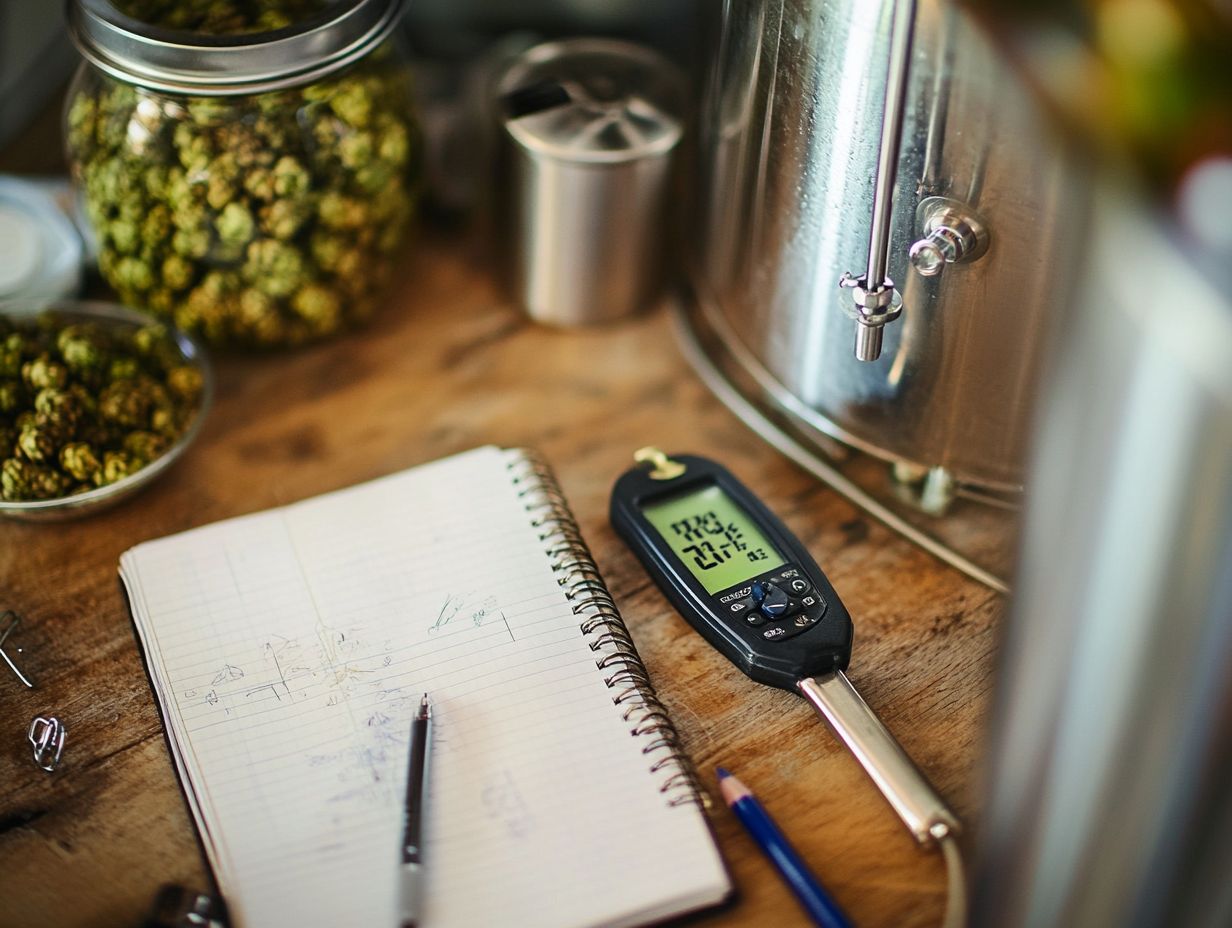
Temperature is crucial for the flavor of beer. It influences fermentation, yeast activity, and hop utilization, which define the beer’s aroma and taste.
Fine-tuning fermentation temperatures unlocks various characteristics from yeast and hops. This leads to unique flavor outcomes.
For example, lager yeast thrives at cooler temperatures around 45-55 F. This creates a clean, crisp profile with delicate malt and hop notes, essential for styles like Pilsner and Helles. Utilizing a propane burner for consistent heat during brewing can aid in achieving these precise temperatures.
Ales, on the other hand, are fermented at warmer temperatures, typically between 65-75 F. These can exhibit delightful fruity esters and spicy phenols, enhancing styles like Belgian Dubbel or American Pale Ale. Increasing fermentation temperature amplifies hop aromas and flavors, particularly in hop-forward styles like IPAs. These adjustments can elevate citrus or tropical notes, making your beer distinct and enjoyable!
What Are the Ideal Temperatures for Different Types of Beer?
The ideal temperatures for brewing different types of beer vary significantly. Understanding this can be key to elevating your homebrewing game. Each unique style has its temperature parameters that influence the fermentation process and flavor outcomes.
Take lagers, for example; they thrive at cooler fermentation temperatures, typically between 45 F and 55 F. This allows the yeast to work its magic, producing clean flavors and a crisp finish that lager lovers crave.
Ales prefer a warmer range, generally between 60 F and 75 F. Here, the yeast can unleash a delightful array of fruity esters and phenols, resulting in complex flavor profiles that tantalize the palate.
Maintaining these designated temperature ranges ensures optimal yeast performance. This effectively sidesteps off-flavors that can occur due to temperature fluctuations. Mastering fermentation temperature is not just a technical detail; it s crucial. It impacts yeast health and helps you craft a balanced beer that showcases the desired characteristics of each style, whether you prefer all-grain brewing or extract brewing.
What Are the Common Mistakes Home Brewers Make with Temperature?
Common mistakes you might encounter as a home brewer often arise from a lack of awareness about the critical nature of temperature swings. These fluctuations can drastically alter fermentation and the quality of your final product. Consulting resources like John Palmer’s “How to Brew” can help mitigate these issues.
Without proper monitoring, those temperature changes can lead to undesirable flavors and aromas in your brew. For instance, overlooking environmental conditions like room temperature or humidity can significantly impact yeast activity and overall fermentation. Using tools like ThermoWorks ChefAlarm provides accurate temperature readings to help you stay on track.
Investing in reliable thermometers and regularly checking temperatures at each brewing stage is essential. Making adjustments during crucial phases, such as fermentation and conditioning, is vital to maintaining consistency.
A strike temperature calculator can help achieve the ideal mash temperature. Keeping a detailed journal of your observations helps you identify patterns. This practice refines your technique with each batch.
Engaging with online communities like Homebrew Finds can provide more valuable brewing tips.
How Can One Control Temperature during the Fermentation Process?
Controlling temperature during the fermentation process is crucial for producing high-quality beer, as it directly influences yeast behavior and, consequently, the beer’s flavor, aroma, and overall characteristics. Whether you’re employing the BIAB method or traditional techniques, this control is essential.
Maintaining an optimal thermal environment throughout fermentation can significantly enhance both your brewing experience and the final product. One effective strategy is to utilize temperature-controlled fermentation chambers, which enable you to precisely manage conditions tailored to the specific yeast strain you re using, ensuring a more consistent fermentation process. Brands like ThermoWorks offer reliable solutions for this purpose.
Additionally, employing insulation techniques on your fermentation vessels can help mitigate external temperature fluctuations that could disrupt yeast activity. Equip yourself with tools like carboy handles for easier transport and adjustment, and use blow-off tubes to manage excess pressure while avoiding any temperature spikes. Some brewers even use a mummy bag mash to keep their fermenters insulated.
Don t overlook the importance of initial yeast starter temperatures; these are crucial for setting the stage for yeast performance, ultimately influencing the beer’s profile. Properly oxygenating the wort at this stage can also significantly impact fermentation efficiency.
What Are Some Tips for Maintaining Consistent Temperature in Home Brewing?
Maintaining a consistent temperature in home brewing is critical for creating optimal brewing conditions, and several strategies can help you avoid temperature swings and achieve better results with your beer. Even the renowned Charlie Papazian emphasizes this in his book “The Joy of Homebrewing”.
To start, consider investing in high-quality insulating materials, as they can greatly reduce heat loss during the brewing process. For example, wrapping your fermenters in insulation blankets not only stabilizes the temperature but also minimizes fluctuations caused by external conditions. For extreme cases, a mummy bag mash can provide additional insulation.
Incorporating temperature control devices, like thermostats and heating mats, allows for precise regulation of your brewing environment. It’s also essential to regularly monitor your equipment; using digital thermometers for accurate readings will help you swiftly identify any abnormalities. A great resource for brewing equipment reviews is Homebrew Finds.
By adopting these strategies, you can create a controlled environment that enhances the flavors and leads to more consistent brews, elevating your home brewing experience to new heights.
How Can One Use Temperature to Create Unique Flavors in Beer?
Using temperature as a tool to create unique flavors in beer is a captivating aspect of the brewing process, where the nuances of temperature can either enhance or suppress various flavor compounds produced during fermentation. You can harness this approach strategically at different stages to craft distinct flavor profiles that align perfectly with your vision for the final product. Books like Randy Mosher’s “Radical Brewing” delve into these advanced techniques.
For instance, starting fermentation at cooler temperatures allows for the development of crisp, clean flavors, characteristic of lagers. As you gradually raise the temperature, you can introduce more fruity esters and phenolic notes, typical of ales. Belgian-style beers truly excel when fermented at warmer temperatures, as this encourages the yeast to produce those delightful spicy and fruity notes, effectively transforming the beer’s overall character. Authors like John Palmer and Charlie Papazian provide excellent insights on these methods in their books “How to Brew” and “The Joy of Homebrewing”.
By understanding and manipulating these temperature dynamics, you can refine your brewing craft and explore a vast array of creative flavor combinations. For practical applications, consider using wort chillers to quickly cool your wort and lock in those unique flavors.
Frequently Asked Questions
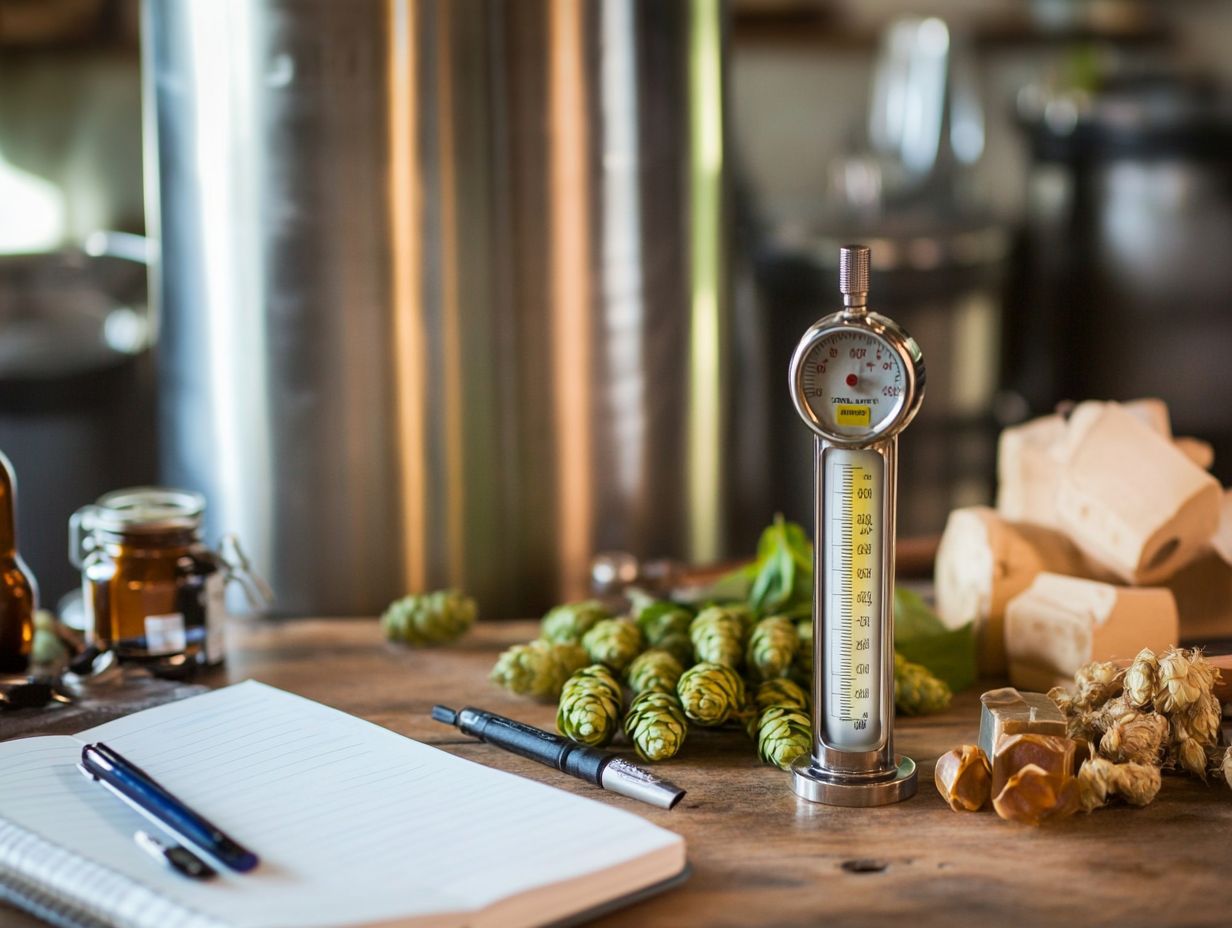
1. What are the 5 essential temperature tips for home brewing?
Essential Temperature Tips for Home Brewing
1. Five Essential Temperature Tips
The 5 essential temperature tips for home brewing are maintaining a consistent temperature, using a thermometer, monitoring the temperature during fermentation, understanding the ideal temperature range for your specific beer, and adjusting the temperature if necessary.
Resources from Green Bay Rackers are also invaluable.
2. Importance of Consistent Temperature
Maintaining a consistent temperature is vital during home brewing. It ensures the consistency of the final product and affects the beer s flavor, clarity, and alcohol content.
3. The Role of a Thermometer
A thermometer allows you to measure the beer’s temperature at various brewing stages. This helps ensure it stays within the ideal temperature range.
Brands like ThermoWorks offer high-quality thermometers for this purpose.
4. Monitoring During Fermentation
Monitoring the temperature during fermentation is essential. Yeast is sensitive to temperature changes, which can lead to off-flavors if not kept within the right range.
Utilizing tools like an auto-siphon can also help maintain a sealed environment to prevent contamination.
5. Determining Ideal Temperature Range
You can find the ideal temperature range by researching optimal brewing temperatures for your specific beer style. This information is often available on yeast packages or in home brewing recipes.
Consulting “The Joy of Homebrewing” by Charlie Papazian can also provide valuable insights.
6. Adjusting Temperature
If your beer’s temperature is too high, move the fermenter to a cooler spot or use a cooling system. Conversely, if it s too low, use a heating system or find a warmer location.
It is crucial to make adjustments to maintain a consistent and appropriate temperature for optimal brewing.
Tools like wort chillers and boiling water can help you make quick temperature adjustments.
